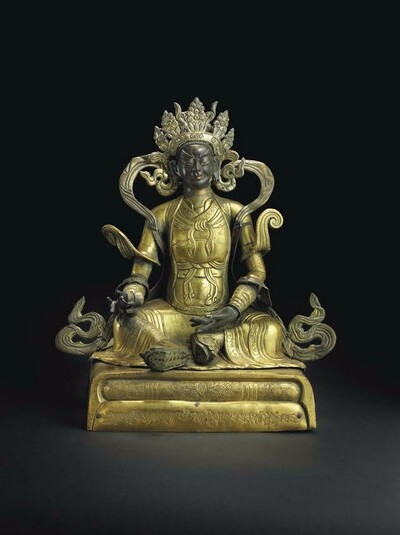
Item: Deity
| Origin Location | China |
|---|---|
| Lineages | Buddhist |
| Material | Metal |
| Collection | Private |
Classification: Deity
Yaksha Mahabala (nor dzin tob po che).
"The sound of a damaru and the uttering of mantra. Generous Nordzin Tobpoche".
ཅང་ཏེའུ་སྐད་དང་སྔགས་ཀྱི་སྒྲ། སྦྱིན་མཁས་ནོར་འཛིན་སྟོབས་པོ་ཆེ།
cang te'u skad dang sngags kyi sgra. sbyin mkhas nor 'dzin stobs po che.
'King Appearance' in Himalayan art is a specific type of figurative form. The principal characteristics are the face often with a stern look achieved by upturned eyebrows accompanied by a mustache and goatee. The clothing is heavy and layered with multiple colours, a cloth head covering or hat sometimes with a small jeweled crown, and boots on the feet. They can hold any number of objects in their hands.
There is a minor classification of figure in Tibetan and Indian art known as a Yaksha. These figures are the basis for the King Appearance in art. Yakshas are identical in general appearance to the Four Guardian Kings, Vaishravana in his many forms as a wealth and protector deity, Jambhala and his many forms, Aparajita and others. The Yaksha figure is typically male, slightly bearded, rotund, wearing heavy layered clothing, or armor, or sparsely clad with silk-like garments. In the system of the Eleven Iconographic Forms figures like Vaishravana, Jambhala and Aparajita belong to King Appearance.
Jeff Watt 2-2014
Tibetan Printed Script (Uchen)
Wylie Transliteration: cang te'u skad dang sngags kyi sgra. sbyin mkhas nor 'dzin stobs po che.
View other items in the Thematic Set: Collection: Christie's. Jan. 28, 2014
